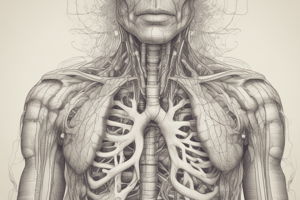Podcast
Questions and Answers
What is the primary function of the nasal cavity?
What is the primary function of the nasal cavity?
- To facilitate vocalization and speech
- To separate the oral cavity from the pharynx
- To filter, warm, and moisturize inhaled air (correct)
- To absorb oxygen and expel carbon dioxide
Which of the following best describes phonation during exhalation?
Which of the following best describes phonation during exhalation?
- The vocal folds always remain closed during phonation
- The loudness is dependent on the vocal cord thickness
- The frequency is determined by the volume of air
- The loudness is determined by air pressure and frequency by vocal rim width (correct)
How does the air tube differ in structure compared to the bronchi?
How does the air tube differ in structure compared to the bronchi?
- The air tube is shorter in length than the bronchi
- The air tube is made up of solid bone, while bronchi are elastic
- The air tube does not contain cartilage, unlike bronchi
- The air tube consists of horse-shoe-like cartilages connected by elastic membranes (correct)
What occurs during the swallowing process regarding the larynx?
What occurs during the swallowing process regarding the larynx?
What type of contraction occurs in the diaphragm during inhalation?
What type of contraction occurs in the diaphragm during inhalation?
How does the bronchial tree characterize the division of bronchi?
How does the bronchial tree characterize the division of bronchi?
What causes the negative intrapulmonary pressure during breathing?
What causes the negative intrapulmonary pressure during breathing?
What happens to the vocal rim during coughing?
What happens to the vocal rim during coughing?
Flashcards
Nasal Cavity Structure
Nasal Cavity Structure
The nasal cavity is divided by the septum into two halves, not perfectly symmetrical. The palate separates it from the mouth.
Nasal Cavity Function
Nasal Cavity Function
It involves warming, cleaning, and humidifying the air we breathe.
Phonation
Phonation
This process occurs when the air passes between the vocal folds during exhalation, similar to the strings of a violin.
Vocal Fold Function
Vocal Fold Function
Signup and view all the flashcards
Swallowing Mechanism
Swallowing Mechanism
Signup and view all the flashcards
Air Tube (Trachea)
Air Tube (Trachea)
Signup and view all the flashcards
Bronchial Tree
Bronchial Tree
Signup and view all the flashcards
Physiology of Breathing
Physiology of Breathing
Signup and view all the flashcards
Study Notes
Respiratory Tract Anatomy
- Respiration involves the intake of oxygen and the removal of carbon dioxide, a waste product of cellular metabolism.
- Every cell in a mammal relies on this gas exchange, a crucial function of the cardio-respiratory system.
Nasal Cavity
- The nasal cavity is divided by a septum, although not perfectly symmetrical.
- The hard and soft palate separate it from the oral cavity.
- The posterior nasal cavity connects to the nasopharynx.
- Functions include heating, cleansing, and moisturizing the inhaled air.
Paranasal Sinuses
- These air-filled spaces are located within the skull bones surrounding the nasal cavity.
- They enhance the voice and enable self-hearing.
Larynx
- The larynx (voice box) is a cartilaginous structure.
- Key components include the hyoid bone, epiglottis, vocal cords, and various cartilages (corniculate, cuneiform, thyroid, cricoid, epiglottis).
Phonation
- During exhalation, air passes through the gap (glottis) between the vocal folds.
- Sounds are produced through varying air pressure and vocal fold width.
- The volume and pitch (frequency) of the sound depend on the air pressure and the width of the vocal folds.
Swallowing
- The tongue root propels the epiglottis downwards, closing off the entrance to the larynx.
- Food then travels down the esophagus.
- The vocal folds also close as a safety mechanism during swallowing.
- During coughing, the vocal folds first close, and then suddenly open when the pressure of exhaled air surpasses the laryngeal closing force.
The Lower Airways
- The trachea, or windpipe, is an elastic tube (~12cm long), consisting of C-shaped cartilages connected by elastic membranes.
- It branches into two main bronchi (one for each lung).
- The right lung is divided into three lobes, the left into two lobes, leading to further divisions into smaller bronchi, forming a bronchial tree.
Alveoli
- Alveoli are tiny air sacs in the lungs where gas exchange occurs.
- These sacs are delicate structures embedded in a thin membrane called the air-blood barrier.
Physiology of Breathing
- Breathing involves the negative pressure of the lungs, which sucks air inside.
- Chest expansion happens via the diaphragm (flattens during contraction) and intercostal muscles (lift ribs).
- Auxiliary respiratory muscles also contribute, originating from the cervical (and upper thoracic) spine and connected to the ribs
Inspiration and Expiration
-
Inspiration (breathing in) expands the chest cavity, increasing volume and lowering pressure inside the lungs, drawing in air.
-
Expiration (breathing out): The chest cavity shrinks due to relaxation of muscles, increasing pressure inside the lungs, forcing air out.
Air Composition
- Air is a mixture of gases, primarily nitrogen, oxygen, carbon dioxide, and trace noble gases.
- Relevant percentages of each gas in the inhaled and exhaled air.
Studying That Suits You
Use AI to generate personalized quizzes and flashcards to suit your learning preferences.




